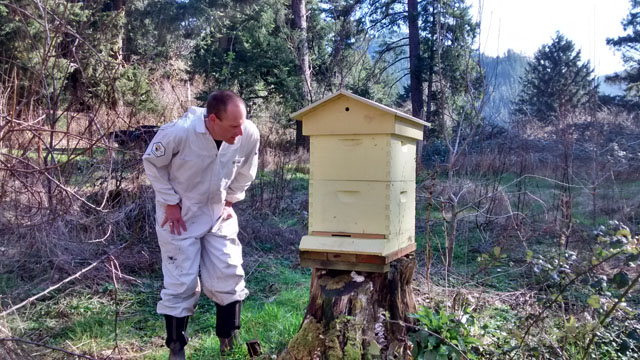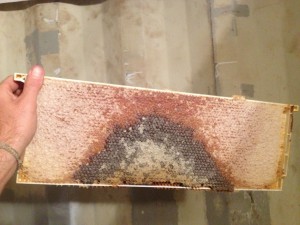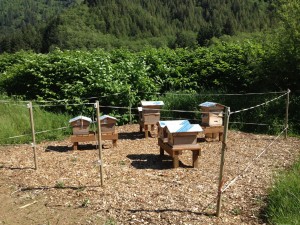 … and the other reason I’ve not been chatty lately is that the honey harvest is on. It takes more and more time each year, for a few reasons:
… and the other reason I’ve not been chatty lately is that the honey harvest is on. It takes more and more time each year, for a few reasons:
- I have more and more hives each year. Right now, I have almost 20.
- The colonies inside them are becoming more mature, and able to gather and store more honey than a newer colony.
- The Cozy Bee Project is taking a portion of my available bee time.
 Before I talk about that third item, I want to show you something interesting and educational. What you see here is a capped honey frame I pulled out of one of my hives a few days ago. In this part of the country, we have two distinct honeyflows: “wildflower,” or basically anything the bees can get, which is probably more than half Himalayan Blackberry. They gather this all summer long, starting in May or so and going until mid August. Then, about the time all the other flowers dry up, the Japanese Knotweed sets flowers. This happens in the last week of August and the first week of September, and the nectar is dark like molasses. You can se it distinctly in the middle of the frame… look at that color difference!
Before I talk about that third item, I want to show you something interesting and educational. What you see here is a capped honey frame I pulled out of one of my hives a few days ago. In this part of the country, we have two distinct honeyflows: “wildflower,” or basically anything the bees can get, which is probably more than half Himalayan Blackberry. They gather this all summer long, starting in May or so and going until mid August. Then, about the time all the other flowers dry up, the Japanese Knotweed sets flowers. This happens in the last week of August and the first week of September, and the nectar is dark like molasses. You can se it distinctly in the middle of the frame… look at that color difference!
The second interesting thing here is the pattern. Honey frames like this one are located towards the top of the hive, and the bees fill them in from the upper corners inward. You can see how far they got by the third week of August, When the honey they were bringing in suddenly changed colors. Usually, it ends up being that a frame is mostly one color or the other, but this one is a pretty even mix and makes a great showpiece. It is inconvenient, though, for extracting the honey, because I sort the frames by color before I spin out the honey, so that I can have two distinct types to sell. What to do with this one? I don’t know.
 Back to the Cozy Bee Project. Now that the honey has been harvested, I’m working on bottling up all the Tasty Gifts ™ that my backers will be getting in a few weeks, printing cool stickers, making lip balm, and all that jazz. In the next few days, I also need to do a lot of work with the bees, to get ready for the winter:
Back to the Cozy Bee Project. Now that the honey has been harvested, I’m working on bottling up all the Tasty Gifts ™ that my backers will be getting in a few weeks, printing cool stickers, making lip balm, and all that jazz. In the next few days, I also need to do a lot of work with the bees, to get ready for the winter:
- Move several hives, so they are all in the new apiaries.
- Inspect all the hives, to be sure they are strong, and consolidate any that aren’t.
- Sample the varroa infestation rate to determine which need treatment.
- Take bee samples from each colony to mail to OSU’s honeybee lab for Nosema analysis.
- Test the software update on the Bee Certain temp/ humidity trackers. We’ve been having some technical problems with it, but Bob the engineer is working diligently and says the new units should be ready by Friday.
- Buy and install a second electric fence charger at the Nehalem apiary, because someone saw bear sign and I don’t want to take any chances.
As you can see, IT’S CRAZY RIGHT NOW. Luckily, my energetic young apprentices Allyson and Emily have volunteered to help me get it all done! But in a month or so, things will slow down to a standstill when the bees go dormant and I’m sitting by the fire, out of the chill Northwest drizzle.

